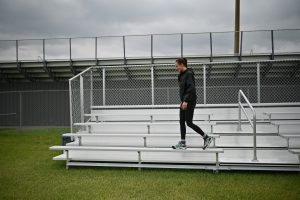Managing Achilles Tendinopathy
I’ve been dealing with a mini achilles tendinopathy flare since going from barely running to playing 1-2 games of soccer a week.
Here’s how I am managing it from a physiotherapist’s perspective.
Achilles tendinopathy (which previously was called tendinitis, except we no longer assume that there is inflammation involved, hence dropping the ‘itis’) can be a stubborn condition. You should always get assessed by a professional because there can be many different injuries that occur at the heel and near the tendon.
Here are a few hallmark signs of Achilles tendinopathy:
- <30 mins stiffness in the morning
- it warms up with activity
- usually was triggered by a sudden change in load (ie. like me going from barely running to full sprinting and cutting in soccer games)
- pain is related to loading of the tendon
Managing Achilles Pain with Exercise
Our tendons NEED load to improve. Resting and then returning to your activity likely won’t give you the result you were expecting. Your tendon might feel better temporarily but when you go to re-load it, the pain is likely to return.
During rehabilitation for your achilles tendon, some soreness is ok – this is subjective and can be a good reason to see a physio to discuss how to determine your tolerable level without continuing to overload the tendon.
This model is from the Barcelona Tendon Rehab Guide (2021) and is a good green light, yellow light, red light system for monitoring pain:

Rehabilitation Exercises for Achilles Tendon Pain
Please see your physio to determine your entry point to certain exercises and to track your pain and progress.
General rule of thumb:
- Isometrics can be used if you find they help your pain but they aren’t required
- Double leg exercises will be less load on the injured side, eventually progress to single leg
- Slower exercises work more of the muscle which is needed for thorough rehab but won’t challenge the tendon
- Faster exercises will begin to challenge the tendon and likely will cause more soreness and discomfort (energy storage and release – the stretch shortening cycle)
- You may need to decrease the amount of the aggravating activity to be able to build back up

Exercise Examples
Calf Raise Options:
- For muscle strength – load up with weight so that you only have about 3-4 reps left in the tank after a set of 5
- You can set a metronome around 60-70bpm
- For tendon strain – go bodyweight
- Set a metronome to around 120-150bpm
- Start double leg for all exercises, and eventually progress to single leg
Video examples (easy to harder):
- Seated soleus raise: video
- 2 up 1 down calf raises: video
- Tip toe walking and single leg eccentric calf raises: video
- Single leg calf pulses: video
Jumping, hopping and running
It is good to monitor how much hopping and plyometric exercises you are doing so that if you notice more pain the next day, you will know you did too much and how to scale it back
- Start double leg hopping, and progress to single leg on the spot hopping
- Complete stair climbing for 2-3 minutes, at 120bpm metronome
- Progress to single leg forward hops
- Progress to side to side single leg hops
- Incorporate running as tolerated
Video examples (from easier to harder):
- Front foot elevated pogo: video
- Single leg pogo: video
- Stair climbing from 140bpm to 170bpm: video
- This is from Jill Cook (the tendon GOAT)
- Side to side hops at 170bpm: video
Why use a metronome?
Tendon neuroplastic training relates to the brain changes that happen with a tendon injury. The connection from our brain to tendon changes – the inhibition and excitability are not the same as pre-injury. To retrain this, we use external cueing, like a metronome, to work on the neuroplastic changes and to reduce the inhibition the brain initially learned to use as a protective mechanism for the painful area.
Metronome beats per minute:
- at 60-100 bpm were are working our muscle units
- at 120-150 we start to work our tendon units
Remember, Achilles tendon pain and pathology can take up to (and sometimes more) than 12 months to get rid of symptoms. The key to remember is that you CAN stay active during this injury process. Ask your physio for more info!
Need more guidance? Book a 1:1 virtual session to discuss your training.
If you want a controlled, physio-guided program to return to hopping and running with a foot tendon injury, try the Tib Post Tendon Injury rehab program on Ripple.

Sign up to my monthly newsletter to get injury tips straight to your inbox:
References:
- Cook, Rodas, et al. “Tendon Injuries in Football Players: FC Barcalona 2021 Tendon Guide.” The diagnosis and management of lower limb tendinopathy. Barca Innovation Hub. (2021).
- Rio E, Kidgell D, Moseley GL, et al. Tendon neuroplastic training: changing the way we think about tendon rehabilitation: a narrative review. British Journal of Sports Medicine 2016;50:209-215.
- Baxter, Josh R., et al. “Exercise Progression to Incrementally Load the Achilles Tendon.” Medicine and Science in Sports and Exercise 53.1 (2021): 124-130.


